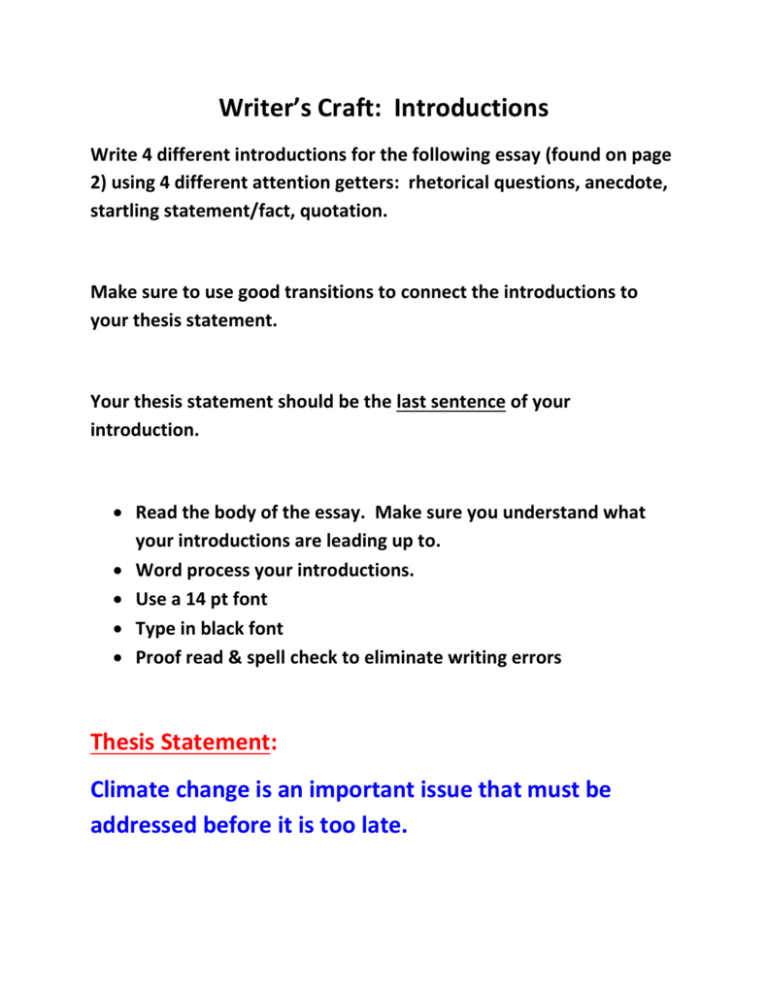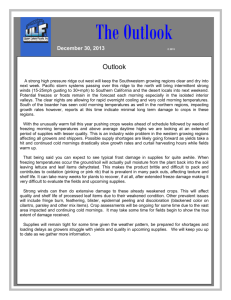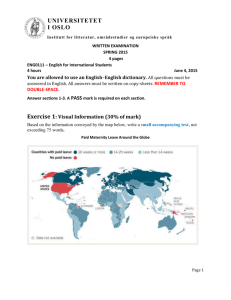Introductions: Writing Assignment
advertisement

Writer’s Craft: Introductions Write 4 different introductions for the following essay (found on page 2) using 4 different attention getters: rhetorical questions, anecdote, startling statement/fact, quotation. Make sure to use good transitions to connect the introductions to your thesis statement. Your thesis statement should be the last sentence of your introduction. Read the body of the essay. Make sure you understand what your introductions are leading up to. Word process your introductions. Use a 14 pt font Type in black font Proof read & spell check to eliminate writing errors Thesis Statement: Climate change is an important issue that must be addressed before it is too late. The Peril of Climate Change [Write your introduction in this field. Make sure to end with the thesis statement as the last sentence of your introduction.] One reason that climate change must be addressed is because of the problems it creates due to rising ocean temperatures. As ocean temperatures rise, the water becomes too warm for algae to survive. Algae is crucial to maintaining the proper balance of oxygen and carbon dioxide in the Earth’s atmosphere. As algae absorbs carbon dioxide, it produces the oxygen necessary for human life. Although terrestrial plants are obviously primary producers of oxygen, planktonic algae and cyanobacteria account for nearly half of the primary oxygen production on the planet. For at least a billion years before plants evolved, microbes were the only organisms producing O2 on earth. (Neal, 43) Now, as algae levels are reduced, oxygen production is reduced as well. This reduction of oxygen levels further contributes to an imbalance of oxygen and carbon dioxide in the atmosphere which in turn sets the stage for further global warming. A second reason that climate change must be addressed is due to the problems caused by rising sea levels. With rising temperatures, the polar icecaps are melting. This melting of the polar icecaps has a tremendous effect on sea levels. Scientific research indicates sea levels worldwide have been rising at a rate of 0.14 inches (3.5 millimeters) per year since the early 1990s. The trend, linked to global warming, puts thousands of coastal cities, like Venice, Italy, and even whole islands at risk of being claimed by the ocean. (Vaughn, 68) Large ice formations, like glaciers and the polar ice caps, naturally melt back a bit each summer. But in the winter, snows, made primarily from evaporated seawater, are generally sufficient to balance out the melting. Recently, though, persistently higher temperatures caused by global warming have led to greater-than-average summer melting as well as diminished snowfall due to later winters and earlier springs. This imbalance results in a significant increase in runoff versus evaporation for the ocean, causing sea levels to rise. Not only do the rising sea levels themselves create problems, but they also increase the damage done by storms due to the effect of higher waves and erosion attacking the shoreline. This damage will be very costly. A possible rise in sea levels by 0.5 meters by 2050 could put at risk more than $28 trillion worth of assets in the world's largest coastal cities, according to a report compiled for the insurance industry. (Vaughn, 87) A final reason that climate change must be addressed is due to the effect on regional weather and the problems created by changing weather patterns. Extreme weather events, droughts and the resulting food shortages, and the spread of diseases due to insect migration can all be blamed of changing weather patterns. Agriculture and fisheries are highly dependent on specific climate conditions. As weather patterns change regionally and even globally, climate change could make it more difficult to grow crops, raise animals, and catch fish in the same ways and same places as we have done in the past. Changes in temperature, amount of carbon dioxide, and the frequency and intensity of extreme weather could have significant impacts on crop yields. Warmer temperatures may make many crops grow more quickly, but warmer temperatures could also reduce yields. Crops tend to grow faster in warmer conditions. However, for some crops (such as grains), faster growth reduces the amount of time that seeds have to grow and mature. [1] This can reduce yields. More extreme temperature and precipitation can also prevent crops from growing. Extreme events, especially floods and droughts, can harm crops and reduce yields. For example, in 2008, the Mississippi River flooded just before the harvest period for many crops, causing an estimated loss of $8 billion for farmers. (Vaughn 142) Also, many weeds, pests and fungi thrive under warmer temperatures, wetter climates, and increased CO2 levels. The ranges of weeds and pests are likely to expand northward. This would cause new problems for farmers' crops previously unexposed to these species. Moreover, increased use of pesticides and fungicides may negatively affect human health.







